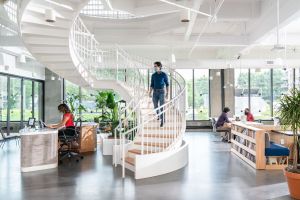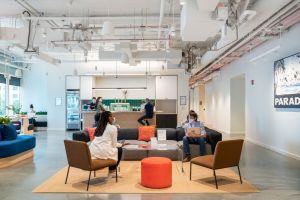Presented By: WeWork
How WeWork’s Model of Returning to the Office Could Help Your Business
WeWork's Guide to a Return to Office Life

While the world has proven that remote work is possible, it’s become clear that working from home has an impact on employee productivity, collaboration and company culture. WeWork, a flexible office space provider with more than 800 locations worldwide, has studied the best ways to prioritize workers’ safety, and implemented these steps in all its buildings.
Commercial Observer’s Partner Insights team spoke with Lendy Krantz, WeWork’s head of global corporate workplace transformation, to learn how to bring employees back to the office with new safety standards.
Commercial Observer Partner Insights: As building managers plan to bring workers back to the office, what are some of the key things that need to be considered?
LK: Two things come to mind. The first is to know the most up-to-date CDC and local guidelines. The second is to define the company philosophy regarding returning to the workplace. When we first started bringing our employees back, we wanted our approach to be phased, helping teams gradually transition. We wanted to make sure they had choices with how and when they returned. We achieved this by supporting them in using their nearest WeWork location. We knew from surveys that reducing commute time would make returning easier, especially if employees can walk or bike to their closest location. We took advantage of that in our plan.
CO: As a plan for returning comes together, what information should be relayed to employees before they return, and how should that information be presented? 
LK: You want to help employees understand your company approach through multiple formats. Some employees learn best through email, some through video, and some look mostly to their manager for guidance. We took all of those approaches into account. We sent out detailed emails, did webinars, and had direct conversations with managers so they had the tools they needed to support their employees.
CO: Some people don’t take the COVID threat seriously. What steps can be taken to ensure that employees adhere to COVID-related safety policies?
LK: Once you have your policies written, prepare an education plan that includes kind, consistent reminders. Then support employees with encouraging talking points they can use when interacting with others in the space that have a similar, education-first, friendly tone, like, “Hey, you might not be aware..,” or, “It would work better for me if you stood a little bit farther away.”
We believe that being able to kindly and compassionately ask for the things we need is an important COVID-readiness skill as well as an important life skill. It’s essential to remind others to speak up with respect and to also listen thoughtfully to each other.
CO: Safety begins at the front door. Talk about the lobby and check-in/screening procedures that office buildings should have in place.
LK: We reduced the flow of employees coming in by staggering arrivals, so there’s more space for social distancing and less demand on the elevators. We also set up temperature checks that scan from a distance. For the elevators, we clean the buttons and have wipes and sanitizer available on landings, and we put spacing dots there so people stand apart from each other.
CO: What should buildings be doing to ensure proper ventilation?
LK: Bringing in air from the outside so there’s full cycling of air, and making sure they’re filtering air as it’s moving through the space. We augmented our HVAC systems, and are meticulous about maintaining the air filters. Our HVAC systems are bringing in more air from outside and running for longer hours.
 CO: What should companies be doing regarding deliveries, messenger packages, and mail?
CO: What should companies be doing regarding deliveries, messenger packages, and mail?
LK: Have lag time where possible after bringing packages in – they should sit for at least 24 hours. You can also explore digitization of mail for employees who aren’t yet back in the office.
CO: What are your cleaning procedures for the offices themselves?
LK: All surfaces are cleaned and sanitized regularly. High-touch surfaces are cleaned every two hours: microwave handles, refrigerators, door knobs, conference room doors. We also make sure we have hand sanitizer and wipes available.
CO: What about the physical layout of the office space? What changes need to be put in place to prioritize safety?
LK: Given the unknowns regarding COVID, take a temporary or short-term approach. It’s important to prioritize flexible options vs. making infrastructural changes, such moving walls or otherwise permanently affecting the design. For example, to de-densify the space, you can easily remove chairs so that fewer people are interacting in a given area. Also, directional signage is key for staircases and hallways to give clear guidance on where people should walk to avoid others. You can start with flexible, temporary options and evolve the infrastructure later as needed.
Learn more about WeWork’s approach to tomorrow by visiting, wework.com/tomorrow.



